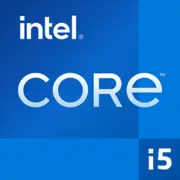Intel Core i5-13450HX

Intel Core i5-13450HX: A Balance of Power and Mobility in 2025
Introduction
With the release of the 13th generation Intel Raptor Lake processors, the company has solidified its position in the mid-range and high-end laptop market. The Core i5-13450HX is one of the most balanced chips in the lineup, combining 10 cores, moderate power consumption, and support for modern technologies. Let's explore who it is suitable for, how it performs in gaming and work tasks, and which laptops featuring it are worth considering in 2025.
Architecture and Process Technology: Hybrid Cores and Raptor Lake Evolution
The Intel Core i5-13450HX processor is built on the hybrid architecture of Raptor Lake (Intel 7 process technology). Its structure includes:
- 6 Performance-cores (P-cores) with Hyper-Threading support (12 threads) — for resource-intensive tasks.
- 4 Efficient-cores (E-cores) without Hyper-Threading (4 threads) — for background processes.
- Base Frequency: 2.4 GHz (P-cores), 1.8 GHz (E-cores).
- Turbo Boost: up to 4.6 GHz for P-cores.
Architecture Features:
- Intel Thread Director — optimizes task distribution between cores, enhancing multi-threaded performance.
- 20 MB L3 Cache — reduces latency when working with memory.
- Integrated graphics Intel UHD for the 13th generation — 32 EU (execution units), supporting 4K@60Hz and AV1 decoding.
In comparison, the previous generation (Alder Lake, Core i5-12500H) had a similar structure but with a smaller cache (18 MB) and more modest Turbo frequencies (up to 4.5 GHz).
TDP 55 W: A Balance Between Power and Heat
The nominal TDP of the processor is 55 W, but actual power consumption varies:
- In Turbo mode: up to 95-100 W (briefly).
- In power-saving mode: 35-45 W.
What does this mean for the user?
- Laptops with the i5-13450HX require an efficient cooling system (2-3 fans, copper heat pipes).
- In compact bodies (e.g., thin gaming models), the processor may throttle under prolonged load.
- For stable performance in gaming or rendering, it’s better to choose devices with adequate cooling — for example, the ASUS TUF Gaming A16 or MSI Katana 15.
Performance: Gaming, Video Editing, and Office Work
Geekbench 6:
- Single-Core: 2354 — on par with the Ryzen 7 7840HS (2300-2400).
- Multi-Core: 11116 — close to the Core i7-13700H (12000).
Real-world tasks:
1. Office Work:
- Running 30 tabs in Chrome + Excel + Zoom — load on E-cores, temperature does not exceed 60°C.
- Battery life: 6-7 hours (at 150 nits brightness).
2. Video Editing:
- Rendering a 10-minute 1080p video in DaVinci Resolve: 8-9 minutes (on the Ryzen 5 7640HS — 10-11 minutes).
3. Gaming:
- Paired with GeForce RTX 4060:
- Cyberpunk 2077 (1080p, Ultra): 65-70 FPS (without ray tracing).
- Fortnite (1440p, Epic): 120 FPS.
- On integrated graphics:
- CS2 (1080p, Low): 60-70 FPS.
Turbo Mode:
- Activates automatically under load, but lasts briefly (20-30 seconds).
- In gaming, it provides an increase of 5-7% in FPS.
Use Cases: Who is the i5-13450HX Suitable For?
1. Enthusiast Gamers — for Full HD/1440p gaming with a discrete graphics card (RTX 4050-4070).
2. Freelancers — video editing, 3D modeling, programming.
3. Students — balance between battery life and performance for study and entertainment.
Examples of Laptops in 2025:
- Gaming: Lenovo Legion 5 Pro (with RTX 4060, 16 GB RAM, 1 TB SSD) — $1300.
- Versatile: HP Victus 16 (RTX 4050, 144 Hz display) — $1100.
- Workstations: Dell Precision 3571 (with Quadro T1000) — $1400.
Battery Life: How Long Will the Battery Last?
With an 80 Wh battery capacity:
- Video Playback: up to 8 hours.
- Chrome Work: 5-6 hours.
- Gaming: 1.5-2 hours (with discrete GPU).
Power-saving Technologies:
- Intel Dynamic Tuning 3.0 — adaptively reduces frequencies during idle.
- Compatibility with Windows 11 Power Slider — “Battery saver” limits Turbo Boost.
Tip: To extend battery life, disable Turbo Boost in the power settings.
Comparison with Competitors
1. AMD Ryzen 5 7640HS (Zen 4):
- Pros: Better integrated graphics (Radeon 760M), lower laptop prices ($1000-1200).
- Cons: Weaker in multi-threaded tasks (Geekbench Multi-Core ~10500).
2. Apple M2 Pro:
- Pros: Battery life up to 18 hours, runs cool.
- Cons: Limited compatibility with Windows software, more expensive (MacBook Pro 14" — $1999).
3. Intel Core i7-13700H:
- Pros: +2 P-cores, Multi-Core ~13000.
- Cons: Laptop prices are $200-300 higher.
Pros and Cons of the Core i5-13450HX
Strengths:
- High multi-threaded performance for its price.
- Support for DDR5-5200 and PCIe 5.0.
- Good upgrade potential (suitable for laptops with 32 GB RAM).
Weaknesses:
- Integrated graphics are weaker than AMD's Radeon 780M.
- Heat under load (requires quality cooling).
How to Choose a Laptop with the i5-13450HX?
1. Cooling: At least 2 fans + performance modes in proprietary software (e.g., ASUS Armoury Crate).
2. Display: For gaming — 144 Hz or higher; for work — IPS with 100% sRGB coverage.
3. Memory: At least 16 GB DDR5, 1 TB NVMe SSD.
4. Price: Optimal range — $1100-1400. Cheaper models (under $1000) often skimp on cooling.
Top 3 Models for 2025:
1. Acer Predator Helios Neo 16 — $1250 (RTX 4060, 165 Hz display).
2. ASUS Vivobook Pro 15 — $1150 (OLED display, 32 GB RAM).
3. MSI Crosshair 17 — $1350 (RTX 4070, mechanical keyboard).
Final Conclusion
The Intel Core i5-13450HX is an ideal choice for those looking for a "do-it-all" laptop:
- Gamers will appreciate compatibility with discrete GPUs like the RTX 4060.
- Designers and developers will find enough power for editing and compiling.
- Students can work untethered for 6-7 hours.
The main advantages are the flexibility of Raptor Lake architecture and an optimal price/performance ratio. If your budget is limited to $1300 but you want maximum capabilities, the i5-13450HX will provide a reliable foundation for the next 3-4 years.
Basic
CPU Specifications
Memory Specifications
GPU Specifications
Miscellaneous
Benchmarks
Compared to Other CPU
Share in social media
Or Link To Us
<a href="https://cputronic.com/cpu/intel-core-i5-13450hx" target="_blank">Intel Core i5-13450HX</a>

